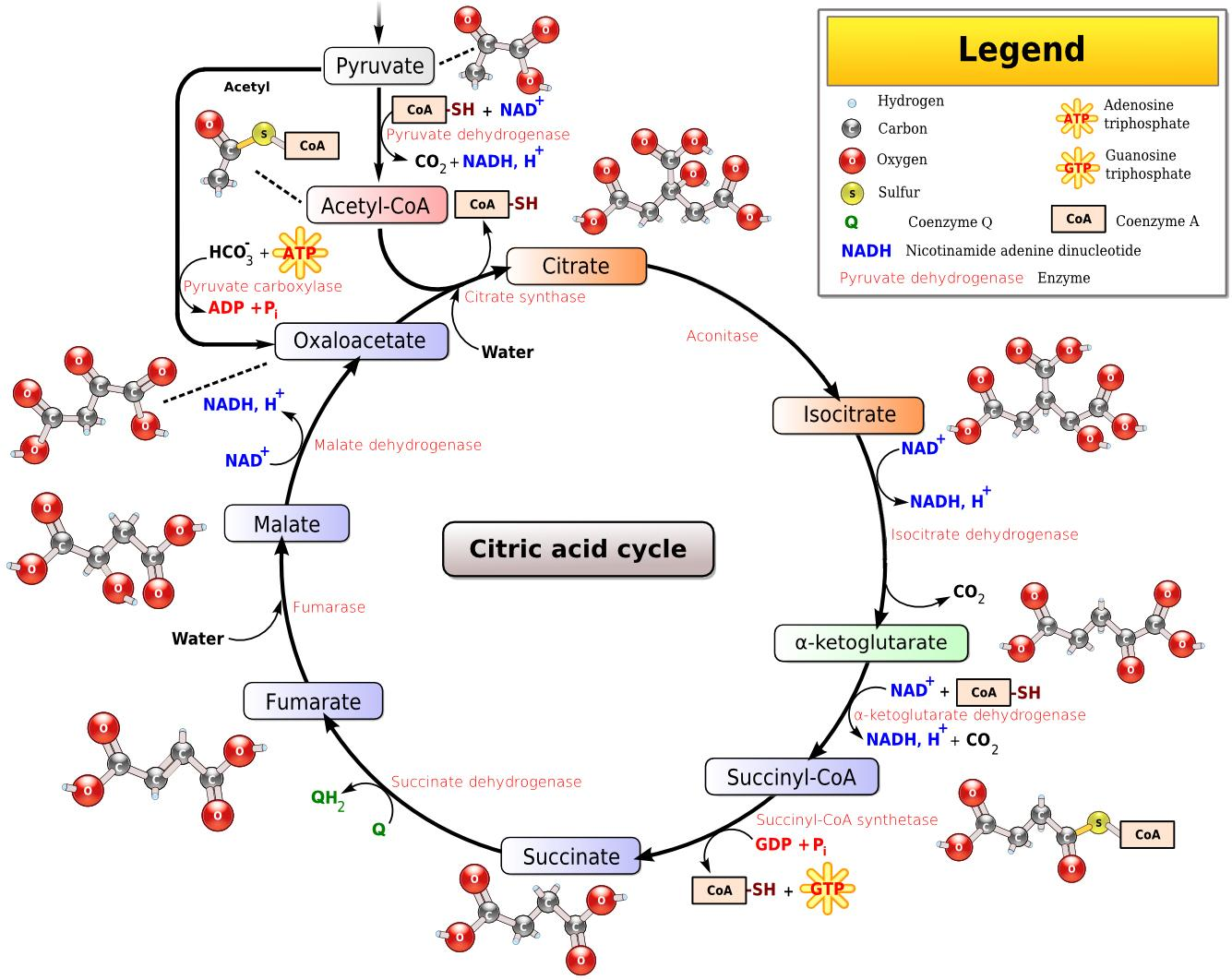
Describe Krebs cycle. (Flow chart or explanation).
Answer
572.4k+ views
Hint: Krebs cycle is a part of aerobic respiration. Aerobic respiration is the process which occurs in the presence of Oxygen to convert food into carbon dioxide, water and energy. Kreb’s cycle is also called the Citric acid cycle or TCA (tricarboxylic acid) cycle.
Complete Answer:
- This cycle is a series of chemical reactions in all aerobic organisms to release energy.
- In the Krebs cycle Acetyl coenzyme A which is derived from the fats, proteins and carbohydrates get oxidized.
- This cycle occurs in the matrix of Mitochondria of a cell.
- Oxidative decarboxylation of pyruvate to Acetyl coenzyme A.
- This is the linkage step between the glycolysis and Kreb’s cycle.
- In this step, the end product of glycolysis i.e the pyruvate is oxidatively decarboxylated to acetyl coenzyme A and carbon dioxide with the help of enzyme pyruvate dehydrogenase.
Steps involved in Krebs cycle:
There are a total 8 steps occurred in the Krebs cycle. These all eight steps are enzyme catalysed.
Products of Krebs cycle:
- Since Kreb’s cycle is a cyclic process, the Oxaloacetate formed at the end of this cycle combines with the acetyl coenzyme A in the next cycle.
- At each turn of Krebs cycle, following energy molecules are produced as-
3 NADH, 1 FADH2, 1 GTP (OR ATP) and 2 Carbon Dioxide molecules

Note: Remember to keep in mind that the Krebs cycle takes place in the Mitochondria of a cell and its purpose is to complete the oxidation of Glucose and producing energy rich molecules that later produce ATP in the Electron transport chain.
Complete Answer:
- This cycle is a series of chemical reactions in all aerobic organisms to release energy.
- In the Krebs cycle Acetyl coenzyme A which is derived from the fats, proteins and carbohydrates get oxidized.
- This cycle occurs in the matrix of Mitochondria of a cell.
- Oxidative decarboxylation of pyruvate to Acetyl coenzyme A.
- This is the linkage step between the glycolysis and Kreb’s cycle.
- In this step, the end product of glycolysis i.e the pyruvate is oxidatively decarboxylated to acetyl coenzyme A and carbon dioxide with the help of enzyme pyruvate dehydrogenase.
Steps involved in Krebs cycle:
There are a total 8 steps occurred in the Krebs cycle. These all eight steps are enzyme catalysed.
| Sl.No. | Steps involved in Krebs cycle | Enzyme used |
| 1. | Condensation of acetyl coenzyme A with Oxaloacetate | Citrate synthase |
| 2. | Isomerisation of citrate into isocitrate | Aconitase |
| 3. | Oxidative decarboxylation of isocitrate | Isocitrate dehydrogenase |
| 4. | Oxidative decarboxylation of alpha-ketoglutarate | Alpha-ketoglutarate dehydrogenase |
| 5. | Conversion of succinyl-coA into succinate | Succinyl-coA synthase |
| 6. | Dehydration of succinate to fumarate | Succinate dehydrogenase |
| 7. | Hydration of fumarate to malate | Fumarate hydratase |
| 8. | Dehydration of malate to oxaloacetate | Malate dehydrogenase |
Products of Krebs cycle:
- Since Kreb’s cycle is a cyclic process, the Oxaloacetate formed at the end of this cycle combines with the acetyl coenzyme A in the next cycle.
- At each turn of Krebs cycle, following energy molecules are produced as-
3 NADH, 1 FADH2, 1 GTP (OR ATP) and 2 Carbon Dioxide molecules

Note: Remember to keep in mind that the Krebs cycle takes place in the Mitochondria of a cell and its purpose is to complete the oxidation of Glucose and producing energy rich molecules that later produce ATP in the Electron transport chain.
Recently Updated Pages
What is the probability that a leap year has 53 Su-class-12-maths-CBSE

What is fringe in wave optics class 12 physics CBSE

From a pack of 52 cards 4 are drawn one by one without class 12 maths CBSE

What is conjugate foci Explain class 12 physics CBSE

Give reasons for the following Woodblock print only class 12 social science CBSE

Which signals get disrupted in case of a spinal cord class 12 biology CBSE

Trending doubts
What are the major means of transport Explain each class 12 social science CBSE

Which are the Top 10 Largest Countries of the World?

Draw a labelled sketch of the human eye class 12 physics CBSE

Explain sex determination in humans with line diag class 12 biology CBSE

The pH of the pancreatic juice is A 64 B 86 C 120 D class 12 biology CBSE

Explain sex determination in humans with the help of class 12 biology CBSE




